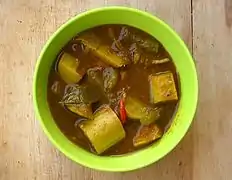Kaeng tai pla
Kaeng tai pla (Thai: แกงไตปลา, pronounced [kɛ̄ːŋ tāj plāː]) is a curry of southern Thai cuisine. Its name is derived from tai pla, a salty sauce made from fermented fish entrails,[1] which gives the curry a strong smell and flavor.
 Kaeng tai pla in Bangkok | |
| Alternative names | Gaeng tai pla |
|---|---|
| Type | Curry |
| Course | Lunch, dinner |
| Place of origin | Thailand |
| Region or state | Southern Thailand |
| Serving temperature | Hot |
| Main ingredients | Fish, vegetables, fermented fish viscera sauce |
This curry is usually served with fresh vegetables in a separate plate and eaten along with steamed rice.
History
Kaeng tai pla or kaeng pung pla[2][3] is a southern food and the famous dish of Phatthalung Province since the King Rama 2 around 200 years ago. Kaeng tai pla is influenced by South India, which is the origin of cooking spices. The application of food culture between traditional Thai and South Indian cuisine. The main ingredient of kaeng tai pla is tai pla or pung pla made from the stomach of the fish to marinate the fish, such as catfish and snakehead fish marinated with salt for about 10–30 days so can take kai pla is used for cooking. The reason for having to bring the stomach of the fish to fermentation is to get tai pla because most of the food of the south is from the sea, but due to the high birth rate, it causes the preservation of kaeng tai pla.
Ingredients

Kaeng tai pla is a highly spicy curry; it has a very intense umami taste. It is made mainly with fish and vegetables. Sometimes it includes prawns and certain variants use coconut milk instead of water.[4]
The usual ingredients of the dish can include bamboo shoots, eggplants, pea eggplants, yardlong beans and fresh chilies.[5] Other vegetables used alternatively are Parkia speciosa, baby corn, pumpkin[6] and also potatoes if bamboo shoots are not available.[7] In the past, only grilled catfish was used in the curry without the addition of any vegetables as the natural sweetness of cooked vegetables was not desirable.[8]
The other ingredients are tai pla sauce, which contributes greatly to its characteristic smell and taste, as well as both dry and fresh chili peppers, shrimp paste, turmeric, lesser galangal, lemongrass, kaffir lime zest and leaves, shallots and garlic.[9]
See also
- List of Thai dishes – Wikipedia list article
- Thai curry – Dishes in Thai cuisine made with curry paste
References
- Akkasit Jongjareonrak et al. Antioxidant activity of fermented fish viscera (Tai-Pla) from short-bodied mackerel, Faculty of Agro-Industry, Prince of Songkla University, Hat Yai, Songkhla, 90112 Thailand
- "ประวัติแกงไตปลา".
- "แกงไตปลา".
- Thai Hot Spicy - Kaeng Tai Pla (แกงไตปลา)
- Kaeng Khae Kai (Katurai Chilli Soup with Chicken)
- Tai pla curry
- Fish Belly (Tai Pla) Curry
- "Southern Thai Ancient Fermented Fish Innards Curry with Grilled Catfish (แกงไตปลาปลาดุกย่างโบราณ ; gaaeng dtai bplaa bplaa dook yaang)". Thaifoodmaster. 2017-06-26. Retrieved 2017-06-27.
- "Southern Thai Ancient Fermented Fish Innards Curry with Grilled Catfish (แกงไตปลาปลาดุกย่างโบราณ ; gaaeng dtai bplaa bplaa dook yaang)". Thaifoodmaster. 2017-06-26. Retrieved 2017-06-27.
External links
- Southern Thai Ancient Fermented Fish Innards Curry with Grilled Catfish - Recipe and the dish history
- Kaeng tai pla recipe
- Bangkok Post - South tantalises Bangkok tastebuds
- Tai pla curry
- Step by step Kaeng tai pla recipe with pictures (in Thai)